
In September of 2002 I contacted the Arizona Department
of Corrections to inquire about making a visit to Fort Grand state prison
in Graham County. I explained that my interest was purely historical. My
favourite author Edgar Rice Burroughs had served there as a member of the
Seventh U.S. Cavalry back in 1896-97 when the place was still an active
military post. Specifically, I wanted to know if any original 19th century
structures still remained that I might examine and photograph.
Jim Robideau, of the ADC media relations office in Phoenix,
informed me by phone that one original fort building still remained essentially
intact. It dated to the early 1880s and had served as the fort commissary
during ERB's army days. Curiously, the structure possessed a rather strange
nickname -- "Brown's Folly" -- which I would learn more about when I made
my visit.
First, however, I would have to undergo a background/security
check -- standard procedure for anyone seeking access to the prison complex.
This required that I furnish the ADC with my full legal name, date of birth
and social security number. After passing this preliminary check I was
further advised not to wear denim pants, chambray shirt, nor any orange
clothing when I made my visit. (No problem, I would wear all white.) In
addition, I would not be allowed to photograph any prisoner or any security
device.
Having agreed to all of the above, I was cleared to meet
Warden Ernest J. Trujillo and his assistant Mr. Robert Patton at the Fort
Grant Unit of the Arizona State Prison Complex Safford on Monday, September
30, 2002, at 11:00 A.M.
On the appointed day I left my home in Tucson about 8:30
A.M. bringing with me two 35mm cameras, one loaded with color film, the
other with black and white. Heading east on 1-10, I traversed the picturesque
San Pedro Valley and Texas Canyon, entering a rocky wonderland once claimed
by the Chiricahua Apaches.
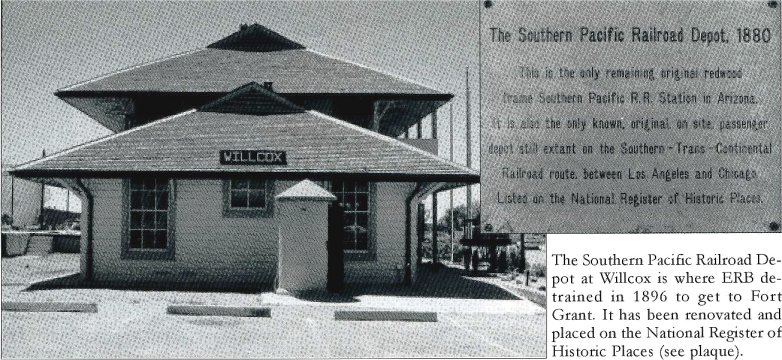
The Southern Pacific Railroad Depot at Willcox is
where ERB detrained in 1896 to get to Fort Grant.
It has been renovated and placed on the National Register
of Historic Places (see plaque).
At Willcox, in Cochise County, I paused to photograph
the recently renovated Southern Pacific Railroad Depot. The two-story wood
frame depot, first erected in 1880, appears as it did in 1914 and currently
functions as Willcox city hall. As I stood before it, listening to the
clatter of passing freight cars, it was easy conjure an image of young
Ed Burroughs training at this very spot on May of 1896 -- his mind teeming
with visions of a dashing military career.
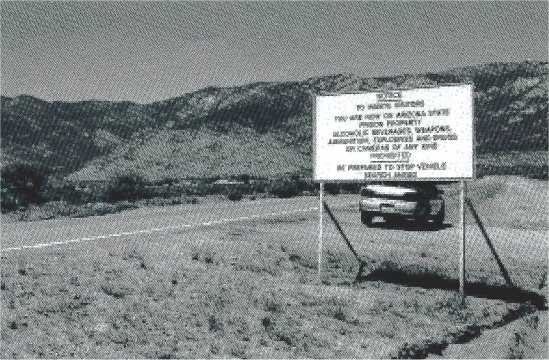
Warning sign approaching Fort Grant State Prison.
The Pinaleno Mountains of Arizona are in the background.
From Willcox there are two approaches to Fort Grant.
Old Fort Grant Road zigzags north through the sparsely populated Sulphur
Springs Valley, connecting with State Route 266 near Bonita. This road
roughly approximates the route ERB travelled by stagecoach as a new recruit
reporting for duty. Though shorter, the last ten miles of Fort Grant Road
are unpaved. I chose the quicker, fully-paved route. This led me east from
Willcox on 1-10, north on U.S. 191 toward Safford, then back west on State
Route 266 through a low pass at the southern end of the Pinaleno Mountains.
It is possible that ERB crossed the Pinalenos near this point.
I arrived at Fort Grant apparently on schedule as Warden
Trujillo pulled up right behind me on his motorcycle. I introduced myself
as a Burroughs Bibliophile and we exchanged friendly greetings as he escorted
m into his office. Soon we were discussing the details of ERB's Seventh
Cavalry experiences. The warden inquired whether any photographs existed
of Burroughs at Fort Grant. I had brought along some ERB material and I
now presented Warden Trujillo with a copy photograph of Ed with his army
pals taken at the fort in 1896. I also provided some photocopies of sketches
ERB had made during his cavalry days. The warden thanked me and it was
obvious that he took an interest in the subject. He indicated that the
material I gave him would be on display.
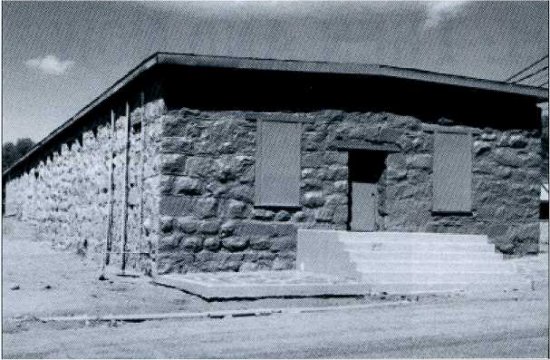
The old Commissary building ("Brown's Folly") at Fort
Grant, Arizona.
ERB shopped here during his cavalry days.
It was built in 1880-1881 and is the only remaining
structure of the original fort.
It was now time for my much anticipated tour of the old
Fort Grant commissary, or quartermaster's store, known as "Brown's Folly."
Stepping outside, the warden and I were greeted by security officer Captain
Bahn who escorted us directly to the prison entrance. After several passes
through an extremely efficient metal detector, I was issued plastic I.D.
tag. Moments later, I found myself on the grounds of a medium security
state prison housing five hundred male inmates.
As Warden Trujillo and Captain Bahn guided me between
rows of low-lying buildings, we were passed by a pick-up carrying a work
detail of prisoners dressed in orange prison garb. I was instantly reminded
of the heavy manual labor that ERB and other enlisted men of the Seventh
Cavalry were faced with daily under Colonel Edwin V. "Bull" Sumner -- labor
that ERB ruefully referred to as "boulevard building." Some things haven't
changed very much since Burroughs was here, I mused.
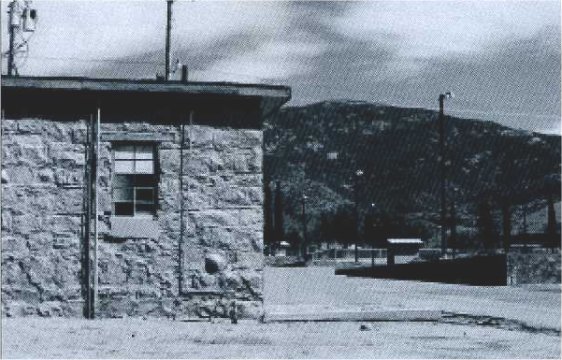
The view from "Brown's Folly" looking northeast with
Mount Graham in the background.
Soon we were standing in front of "Brown's Folly." The
structure is a formidable stone and mortar rectangle, very long, very solid,
clearly quite old. The original roof has been replaced and concrete steps
now stand where a wooden porch once was. Captain Bahn unlocked the front
door and we entered. As I passed through the portal a hundred and six years
melted away as I realized ERB must have done the same many times. This
had been the soldier's store where ERB would have purchased all manner
of personal items -- from clothing to pens, pencils, stamps and stationery.
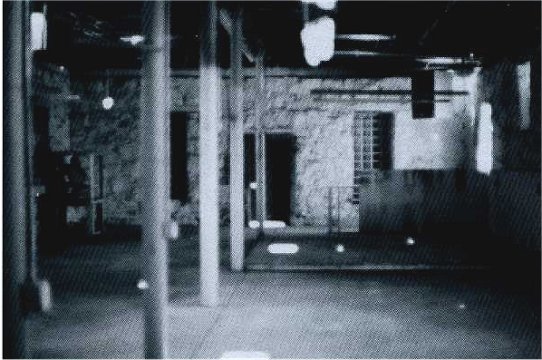
The nearly-bare interior of the Fort Grant commissary,
the only remaining structure from historic Fort Grant.
The building is currently unused and empty, giving the
interior a vaguely eerie , spectral quality. Or so I fancied. I slowly
paced the length of it, gazing at the thick stone walls, taking photographs,
glancing through the high-set windows at a bright Arizona sky. I could
have spent many hours there absorbing the atmosphere, listening for the
voices of long dead soldiers, the bustle of a frontier army post that was
no more. . . But Warden Trujillo and Captain Bahn had other matters to
attend to and they couldn't leave me alone. Reluctantly, I exited.
Next, we circled the exterior which has been painted a
pale blue to match the prison color scheme. I snapped a few more photos
and tarried as long as I dared. I suggested to the warden that it would
be nice if a historical marker could be placed at the spot to help ensure
the future preservation of the building. He agreed that it was a good idea.
Then it was time to go.
In the parking area we were met by Assistant Warden Robert
Patton, who is also the unofficial Fort Grant historian. The four of us
gathered in Warden Trujillo's office where we discussed ERB's cavalry service
and Fort Grant's past. The warden passed around the photos I'd given
him and Mr. Patton briefed me on the background of "Brown's Folly."
According to Mr. Patton, the old commissary was originally
the camp armory. By the late 1880s it had been converted to function as
the commissary. It was used in that capacity until the fort was abandoned
in 1905. The only other original structure that had survived until modern
times was the Fort Grant commanding officer's residence. Unfortunately,
that historic building was destroyed by an arson fire during a 1987 prison
riot. The blaze also destroyed many boxes of old Fort Grant and State Industrial
School records that had been stored at the residence.
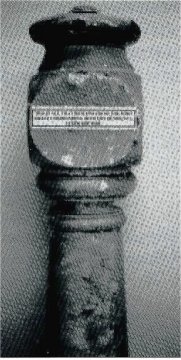
The last remaining artifact from
the Fort Grant commanding officer's residence.
The residence was destroyed by fire during a 1987
prison riot.
But whence the appellation "Brown's Folly" for the commissary?
According to Mr. Patton a certain Colonel Brown was entrusted with $30,000
for construction of the edifice back in 1880-81. The good colonel managed
to get the job done for $10,000, keeping the balance for himself. He was
later court-martialed for his misdeed. The former commissary's nickname
bears testimony to his downfall.
My brief visit was now over. As we filed back outside
to the parking lot, I glanced up at Mount Graham looming just beyond the
prison complex. I had one last question. What route would a cavalry troop
have taken over the mountain in 1896 to get to the community of Solomonsville
(now Solomon) east of Safford. Mr. Patton pointed out an old army wagon
road that began at the rear of the fort and led up the side of Mount Graham
to Grant Falls and Jesus Tanks, on Goudy Creek, and on to Jesus Pass. He
surmised that this may have been the route followed by ERB's B Troop. The
terrain certainly matched Ed's description of a harrowing climb directly
over the Pinaleno range.
Burroughs' hunt for Apache renegades with Troop B, Seventh
Cavalry is notable for two reasons. First, it is remarkable that ERB went
along for the ride at all. Suffering from dysentery and its attendant discomforts,
he was literally falling out of his saddle as he struggled to keep up with
his troop. In his weakened condition he probably should have remained at
the fort.
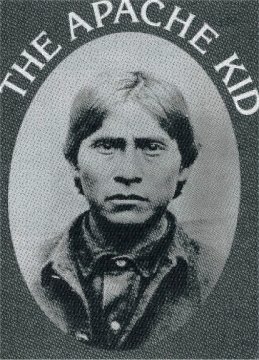
The Apache Kid's native name was "Hashkee Binaa
Nteel,"
meaning "Angry, he has wide eyes."
He was hunted by ERB's cavalry troop in 1896.
Secondly, the fact that ERB's troop was searching for
a legendary outlaw, Apache Kid, ties Burroughs' name -- however loosely
-- to the Apache Kid saga.
The Kid was a hot item in 1896. With a $5,000 price on
his head he was wanted for alleged depredations on both sides of the border.
On June 4, just two weeks after Burroughs arrived at Fort Grant, the United
States and Mexico signed a reciprocal crossing agreement that was specifically
designed to defeat Kid and his band. A day earlier Colonel Sumner had reported
from Grant that Apache Kid was just across the border. Had ERB's troop
run afoul of Apache Kid's band it would have possessed authority to continue
pursuit into Mexico. But Fate was not that kind to Edgar Rice Burroughs.
Kid's life was fascinating and deserves a brief explication
in light of recent research. Born about 1860, Kid was a member of the Aravaipa
Apache band. HIs Apache name is believed to have been Hashkee Binaa
Nteel, meaning "Angry, he has wide eyes." Kid served as a loyal first
sergeant of Apache scouts for the U.S. Army in the 1880s, participating
in major campaigns during the Geronimo wars. He was a close friend and
associate of Al Sieber, the army's venerable chief of scouts.
In May 1887 Sieber left his favorite scout, Apache Kid,
in charge of the scouts and guardhouse at San Carlos Reservation for several
days. During Sieber's absence Kid shot and killed an Indian named "Rip,"
whom Kid believed had instigated the murder of his father. Apache custom
dictated that Kid take this blood vengeance.
On Sieber's return more trouble ensued. A crowd gathered
as Kid rode in and dismounted in front of Sieber's tent. Tension was high
and a general melee erupted. Al Sieber was struck in the ankle by a .45-70
slug, a wound that crippled him for life. Though Kid had not fired a shot
he was court-martialed for mutiny and imprisoned on Alcatraz Island. Sixteen
months later his sentence was remitted by Secretary of War William C. Endicott.
Kid returned to San Carlos, a free man.
The local white citizenry, however, did not want Kid around.
In 1889 Kid was arrested by civil authorities and put on trial at Globe
for "assault with intent to commit murder upon one Albert Sieber." The
charge was false. But Kid was convicted and sentenced to seven years at
Yuma Territorial Prison.
On November 2, 1889, Kid was one of eight Apache prisoners
who escaped from the stage carrying them to Yuma Prison. The Apaches killed
Sheriff Glenn Reynolds and his deputy, and seriously wounded the stage
driver. This incident, known as the Kelvin Grade Massacre, marked the genesis
of Kid's true outlaw career.
Kid sought refuge in the vast Sierra Madre Mountains of
Mexico where he hid out for many years. It is possible that he joined one
of the small remnant groups of "lost Apaches" who refused to give up the
old life-way. Shootouts with these Apaches occurred in Mexico as late as
the 1920s and '30s.
Kid was blamed for many murders and depredations but it
is impossible to determine which crimes he may have actually committed.
Nor does anyone know for certain when or how he died. That is part of the
enigma of Kid. Though several men claimed to have killed him, none ever
collected the reward. Some modern historians believe that Kid lived well
into the 20th century. I like to think that he did.
Burroughs and B Troop never caught up with Apache Kid.
"Angry, he has wide eyes" was too well versed in military ways to allow
the army to ever take him. But ERB's hellish journey over the Pinaleno
Mountains was not made entirely in vain. If nothing else, ERB proved to
himself that he could conquer his physical pain when duty called. Assuming
that he did not exaggerate his ordeal, the first day or two on the trail
must have seemed to ERB like some terrible rite of passage. He could have
remained behind, thus avoiding the experience altogether. But, had he done
so, he would have regretted it for the rest of his life. Perhaps that is
the main reason he chose to go along because the alternative would have
been unthinkable.
Fort Grant remains almost as isolated today as it was
when ERB and his troop searched unsuccessfully for Apache Kid. The mountain
range that ERB crossed is now home to Mount Graham International
Observatory. Astronomers from aouirnd the world come there to do research,
using an array of recently constructed telescopes. The range is home to
Arizona's biggest population of black bears and an endangered species of
red squirrel. Some of the state's oldest living trees are found on
its eastern slopes. Members of the nearby San Carlos Apache Tribe regard
the high peaks as the sacred abode of the Mountain Spirits. They call the
place "Dzil Nchaa Si An," meaning simply "large mountain."
It was, perhaps, the largest mountain in Edgar Rice Burroughs'
life.
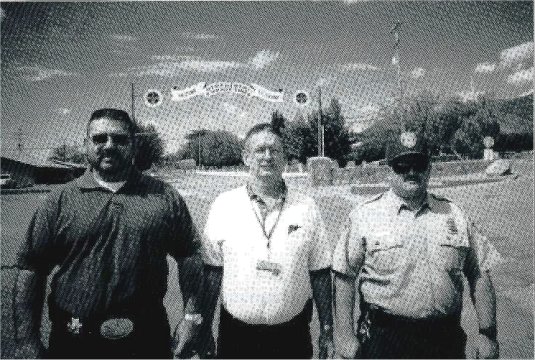
Fort Grant, in Graham County, Arizona, is now part of the state's
Department of Corrections.
Above (left to right) are the Warden, Ernest J. Trujillo; Assistant
Warden Robert Patton;
Security Officer Captain Bahn. All were cordial and helpful to visiting
historian Puncer.
Sources
Alexander, David V. Arizona Frontier Military Place Names 1846-1912.
Las Cruces, NM: Yucca Tree Press, 1998.
de la Garza, Phyllis. The Apache Kid. Tucson: Westermlore Press,
1995.
Hatfield, Shelley Bowen. Chasing Shadows, Apaches and Yaquis Along
the United States - Mexico Border 1876-1911. Albuquerque: University
of New Mexico Press, 1998.
Hunton, Robert L. "On the Trail of Edgar Rice Burroughs: Hiking Arizona's
Eastern Ranges." Burroughs Bulletin New Series, Number 40.
Machula, Papul R. Apache Kid Biography. Online at www.geocities.com/~zybt/kid.htm
(Note: All GeoCities Web sites have been closed down.)
Porges, Irwin. Edgar Rice Burroughs: The Man Who Created Tarzan.
Provo, UT: Brigham Young University Press, 1975.
Sanchez, Lynda A. "The Search for Apache Kid's Daughter." True West
Magazine, January and February, 1999.
Author's personal conversations with Warden Ernest J. Trujillo and Assistant
Warden Robert Patton at Fort Grant Unit, Arizona State Prison Complex -
Safford, September 30, 2002.
Note: Visitors are welcome in the lobby of the administration
building, but to get into the prison grounds to view "Brown's Folly" would
require advance arrangements with the Arizona Department of Corrections.


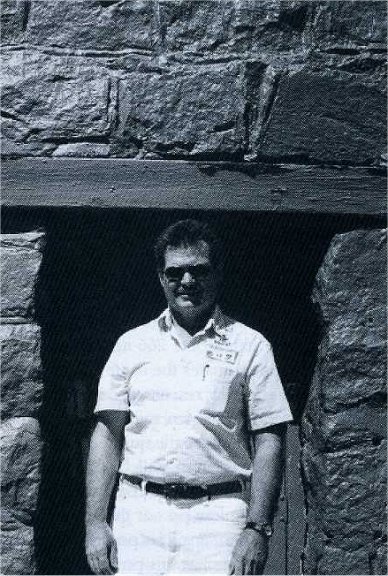
![]()

![]()